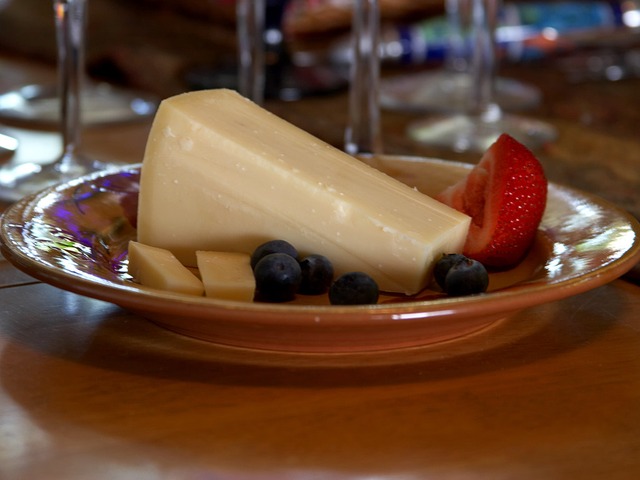Gruyere is a classic hard yellow cheese made in Alpine style. It is a creamy and nutty cheese when young, but forms a more assertive earthy and complex flavor as it matures. Gruyere makes an excellent table and melting cheese. Here’s how you can make Gruyere cheese.
Aging: 5 to 14 months
INGREDIENTS
1) 10 L full cream cow’s milk (preferable pasteurized)
2) 1/4 tsp Danisco TA061 Thermophilic Culture
3) 1/32 tsp of C6 Propionibacterium (optional. This helps produce the characteristic eyes, aroma and flavour associated with Gruyere)
4) 1/2 tsp liquid rennet (mix this in ¼ cup non chlorinated water)
5) 1/8 tsp Calcium Chloride (dilute in ¼ cup non chlorinated water)
6) saturated brine solution
Equipment
1. large pot
2. thermometer
3. curd knife and curd cutter
4. ladle or spoon for stirring
5. cheese cloth
6. cheese hoop with fallower
7. cheese press
8. kitchen timer
9. draining mat
INSTRUCTIONS
Reminder: Sanitize all your equipment before you start to make cheese.
1. Heat the milk to 320 C.
2. Sprinkle the thermophilic culture over the surface of the milk. Let it rehydrate for 5 minutes.
3. Stir the milk in an up and down motion for 2 minutes so the culture is thoroughly mixed with the milk. Make sure you maintain the target temperature of 320 C.
4. Cover the pot and allow the milk to ripen for 30 minutes. Continue to keep the temperature at 320 C.
5. Add the calcium chloride (only if you’re using pasteurized milk). Stir well for 1 minute to thoroughly mix the Calcium Chloride.
6. Add the rennet. Stir the milk up and down in large loops for a minute. Make sure that the milk’s temperature remains at 320 C.
7. Leave the mixture to ripen for 40 minutes to an hour, maintaining the target temperature, to allow the curds to set.
8. Check for a clean break. Poke the surface with a knife. If you can move the curd without the whey filling the space immediately, you’ll know you have a clean break.
9. Cut the curds into ¼ inch or 6 mm cubes with a curd knife (vertical cuts) and a curd cutter (horizontal cuts). Keep the size uniform as much as possible.
10. Gently stir the curds in up and down motion while gradually increasing its temperature to 460 C over the period of 1 hour. Do not heat too quickly or the curds will shrink fast, and the whey won’t separate properly.
11. Remove the pot from the heat and let the curds set for 5 minutes.
12. Line the hoop with a cheesecloth and put it on a colander. If you want to keep the whey, you can put a large pot underneath the colander. You can use the whey to make ricotta.
13. Pour the curds into the cheese hoop.
14. Let the curds drain for a minute.
15. Place the hoop in the cheese press.
16. Press at 11 kg for 1 hour.
17. After an hour, remove the cheese from the press and the hoop. Open the cheese cloth and turn the cheese. Redress the cheese and put it back in the hoop.
18. Press at 22 kg for 12 hours.
19. Remove the cheese from the hoop. Take off the cheesecloth and soak the cheese in brine. Sprinkle a teaspoon of cheese salt on top of the cheese. Soak the cheese in brine for 12 hours, flipping it at the 6 hour mark. Sprinkle another teaspoon of cheese salt on the surface of the flipped cheese.
20. Place the cheese on a draining mat and air dry it at room temperature (200 to 220 C) for 2 to 3 days, flipping it once a day.
21. After 2 to 3 days, wash the surface of the cheese with brine solution.
22. Ripen the cheese at 120 to 140 C for 30 to 40 days. Flip and wash the cheese with brine solution twice a week.
23. Continue to wash the cheese with brine solution 2 to 3 times a week for 8 to 14 months to develop a properly ripened surface.
After 5 to 14 months, you can expect your Gruyere cheese to have a good mature taste. Gruyere is one of the finest cheese used for baking. It has a deliciously distinct but not overpowering taste. You can also use Gruyere as a melting cheese.
More Cheese Making Recipes
Product Feature!
Check out our collection of cheese hoops. We’ve got hoops for different kinds of cheese. Visit our shop today to see the full range of our cheese hoop collection.







